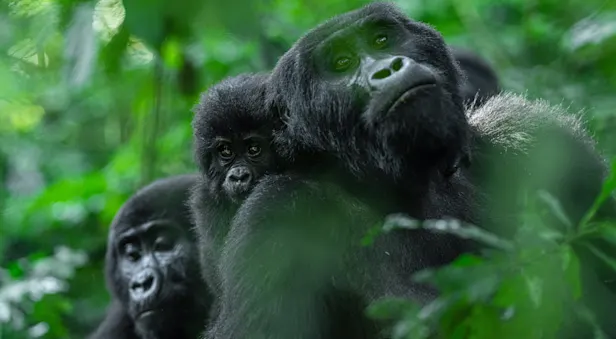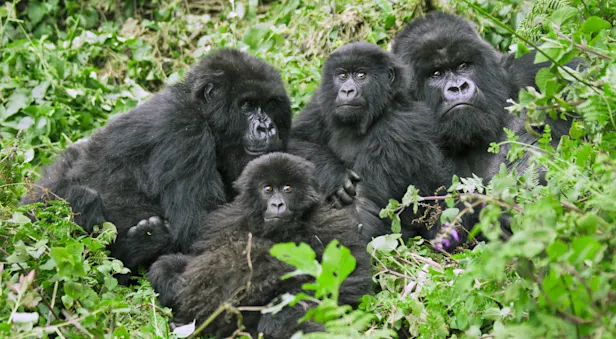
Know Before You Go
Chimpanzee Facts | Uganda & Rwanda Wildlife Guide
Among the apes, it is the chimpanzees that can tell us most about the natural history of our common ancestors. In chimpanzee behavior, we see many similarities to people, such as tool making and the aggressive raiding parties of males. Such traits once thought to be uniquely human actually aren’t. Common chimpanzees live not only in humid, closed-canopy forests, but also in relatively dry areas such as flat savanna where evergreen trees are confined to a few protected gullies. It was in open habitats such as these that our ancestors probably lived. Now, because of the impact of human activities on chimpanzee populations, the race is on to find out how chimpanzees live in their different habitats, before they or their habitats are destroyed.
The common chimpanzee, found north of the Congo River, has been known since the 17th century. There exists much variation in body size and proportions as well as coat and skin color. As many as 14 species were classified in the early 2000s, but only 3 subspecies are now recognized in western, central and eastern populations. However, no distinctive traits have been established for the 3 subspecies, whose validity remains uncertain. Bonobos were first described as a separate species from museum collections in 1929. Their restriction to closed-canopy forests south of the Congo River has protected them from most collectors, and little is known in detail of their distribution or variation.
Physical Characteristics
Both species have stout bodies with backs sloping evenly down from shoulders to hips, which is a result of their relatively long arms (reaching just below the knee when standing erect). The top of the head is rounded or flattened (there is no sagittal crest), and the neck appears short. Their ears are large and projecting, while the nostrils are small and lie above jaws that project beyond the upper part of the face. All of their teeth are large compared to human teeth; however, compared to gorillas, chimpanzees have small molars, appropriate for their fruit diet. Bonobos, or pygmy chimpanzees, have particularly small molars. Despite their name, their body size is not markedly different from common chimpanzees.
Males are larger and stronger than females and have bigger canine teeth, which they use in severe fights with occasionally deadly results. Body proportions are otherwise similar, but both sexes have prominent genitals. Females in heat have prominent swellings of the pink perineal skin, which lasts two to three weeks or more every four to six weeks. Males have relatively large testes.
Sensory Systems
Chimpanzees have similar sensory abilities to humans; it is possible they are better able to distinguish smells. Their large brains reflect a consistently high performance on all intelligence tests devised by humans, including the ability to learn and use words defined by hand signals in languages used by the deaf. In the wild, however, there is no evidence of linguistic abilities. Thirteen categories of chimpanzee calls have been recognized, from soft grunts given while feeding, to loud pant-hoots, consisting of shrieks and roars audible at least 0.6 miles away.
Behavior
Chimpanzees travel mostly on the ground where they “knuckle-walk” like gorillas. Like the other great apes, chimpanzees sleep in “nests”—leafy beds normally made fresh each night. Adults sleep alone and infants with their mothers until the next sibling is born.
Feeding Habits
In all habitats, chimpanzee diets are composed mainly of ripe fruits, which they eat for at least four hours a day. One to two hours daily are spent eating young leaves, particularly in the late afternoon. In long, dry seasons, tree seeds partly replace fruit, and flowers, soft pith, galls, resin and bark are also taken. Chimpanzees eat from as many as 20 plant species a day and 300 species in a year. Whenever possible, they eat large meals from single food sources, which allows them to rest for an hour or two before walking to the next fruit tree. They do not store food, and almost all food is eaten where it is found.
Animal prey makes up as much as 5 percent of the diet. Social insects provide the largest amounts and are collected either by hand (e.g., aggregating caterpillars) or with tools. Females spend twice as much time as males eating insects. Birds are caught only occasionally. Mammals are regular prey in some areas and are known to be eaten particularly by males, wherever there have been long-term studies of chimpanzees. Monkeys, pigs and antelope are the principal prey, especially for young chimpanzees. Hunting occurs irregularly, typically only when prey is surprised in appropriate circumstances. Monkeys, for example, are ignored in continuous canopy forest but are chased if encountered in broken canopy, which offers few escape routes.
Feeding is essentially an individual activity, and during periods of food scarcity, most chimpanzees travel alone or in small family groups (the mother with one or two offspring). Larger parties, often formed when individuals meet at food trees, give no advantages in obtaining food and can sometimes lead to competition for feeding sites. Even when hunting mammalian prey, chimpanzees show little cooperation; more than one chimpanzee may take part in the chase, but once a kill is made, there is intense competition for the carcass. Both at kills and at trees with few large fruits, individuals with food in their hands are surrounded by others trying to take morsels. This leads to “food sharing,” in which scrounging is tolerated apparently because it gives the possessor some peace.
Breeding
Females raised in captivity begin mating at 8 to 9 years of age and give birth for the first time at age 10 or 11. Wild females mature three to four years later. There is no breeding season. Common chimpanzee females are not receptive for three to four years after giving birth then resume sexual activity for one to six months until conception. Female bonobos usually continue sexual activity during much of pregnancy and lactation. Usually a single baby is born after a gestation of eight to nine-and-a-half months; twins are rare.
The newborn chimpanzee is helpless, with only a weak grasping reflex, and needs support from its mother’s hand during travel. Within a few days, it clings to its mother’s underside without assistance and begins riding on her back at 5 to 7 months. By 4 years of age the infant travels mostly by walking but stays with its mother until it is at least 5 to 7 years old. Weaning occurs well before this time, starting in the third year. Mothers groom and play with their offspring and allow younger juveniles to take food from them, which usually only adults can get easily.
Males show precocious sexual behavior, including full intromission of adult females by the age of 2. Complete courtship patterns, however, develop slowly from 3 to 4 years onward. They are normally directed toward females in estrus and consist of nonvocal attention-getting displays by the male sitting with his penis erect. Displays include hair erection, branch shaking and leaf stripping, some of which behavior varies between populations. Females respond by approaching and presenting for mating. Juveniles of both sexes commonly follow the female and approach and touch the male after mating begins. These interfering juveniles make submissive gestures to the mating male, who responds with aggression only to older juvenile males.
Females mate only when in heat, and for the first week or more female common chimpanzees are promiscuous and mate on average six times a day. Toward the last week of estrus, near the time of her ovulation, high-ranking males compete for mating rights by threatening or attacking subordinates who approach the female. Alternatively, an exclusive “consortship” is formed where a female and male elude other members of the community for days or weeks. Although 75 percent of matings occur in the promiscuous phase, pregnancies are most likely to result from consortships. The sexual behavior of bonobos is less well known. They are often promiscuous and, unlike common chimpanzees, sometimes mate from the front.
Chimpanzee Society
All chimpanzees belong to communities that number between 15 and 120 members, although they sometimes travel with individuals from other communities. Neighboring communities have partially overlapping ranges, within which they show either resident or migratory traveling patterns. Resident communities occupy ranges of 4 to 20 square miles and have population densities of 0.4 to 2 per square mile. Within these community ranges, individuals have their own dispersed “core” areas and spend 80 percent of their time within 0.8 to 1.5 square miles. Common chimpanzee mothers often travel alone except for their offspring, covering 1.2 to 1.9 miles per day. Males are more gregarious. Being attracted to other males and to females in heat, males tend to travel further than mothers. Party sizes average from 3 to 6 members for common chimpanzees, and from 6 to 15 for bonobos. Parties of bonobos tend to have equal sex ratios and persist for longer than those of common chimpanzees.
Less is known about migratory communities, which occur in open habitats in the extreme west and east of the chimpanzee’s range where population density falls to 0.02 to 0.4 per square mile. Communities migrate within large ranges of 77 to 154 square miles or more, settling for a few weeks in areas where food is temporarily abundant. When they stop, they appear to behave like a resident community, with females more dispersed and more often alone than males.
Membership of communities is determined by sex. Males very seldom leave the community in which they were born, whereas most females migrate to a new community during an adolescent estrus period. For the young female, a successful transfer occurs when she establishes her own core area within the range of another community where she can feed without aggression from other females. She travels in the company of males for much of the time during her first few months in a new community and thereby obtains protection from hostile females. Females typically make a successful transfer only once, but repeated movements have been documented.
Within communities, relationships between established females are poorly understood but known to range from aggressive to friendly. Female bonobos associate more genital areas together in contexts of social excitement. Male relationships are more overt; tension is routinely expressed in dominance interactions when parties meet. Males also spend much time grooming each other and tend to associate with their maternal brothers, but close associations between other male pairs are also common.
Threats to Survival
There are an estimated 50,000 to 200,000 chimpanzees and bonobos existing in 15 countries. In 9 additional countries, they were known in historical times but are now probably extinct. Their main threat is habitat destruction, particularly commercial logging in places such as the Ivory Coast and Central Congo. Commercial exploitation for overseas trade and hunting for bushmeat have severely reduced populations in some areas, like Sierra Leone and Eastern Congo, respectively. Approximately 10 national parks contain small chimpanzee populations. Given their low reproductive rate, chimpanzees are highly vulnerable to loss of habitat or populations. Common chimpanzees are abundant in captivity, but bonobos have no viable breeding populations outside the wild. Fortunately, in several areas such as parts of Guinea, Congo and Tanzania, chimpanzees are protected by local custom, and they can safely visit fields or even markets.
Header Credit: Richard de Gouveia
































